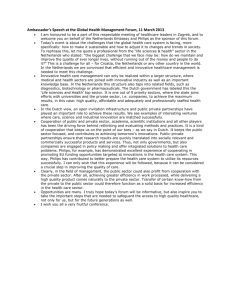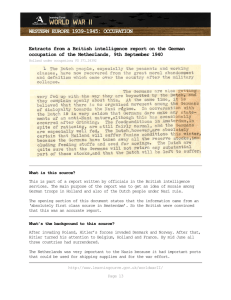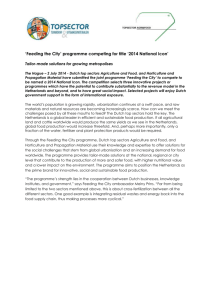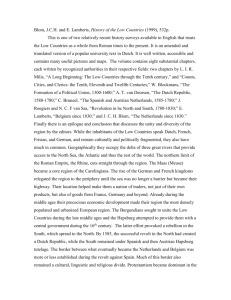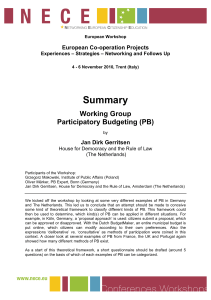“Cultural and Ethnic Diversity in Cities: Challenges and Chances” by Martijn Oosterbaan
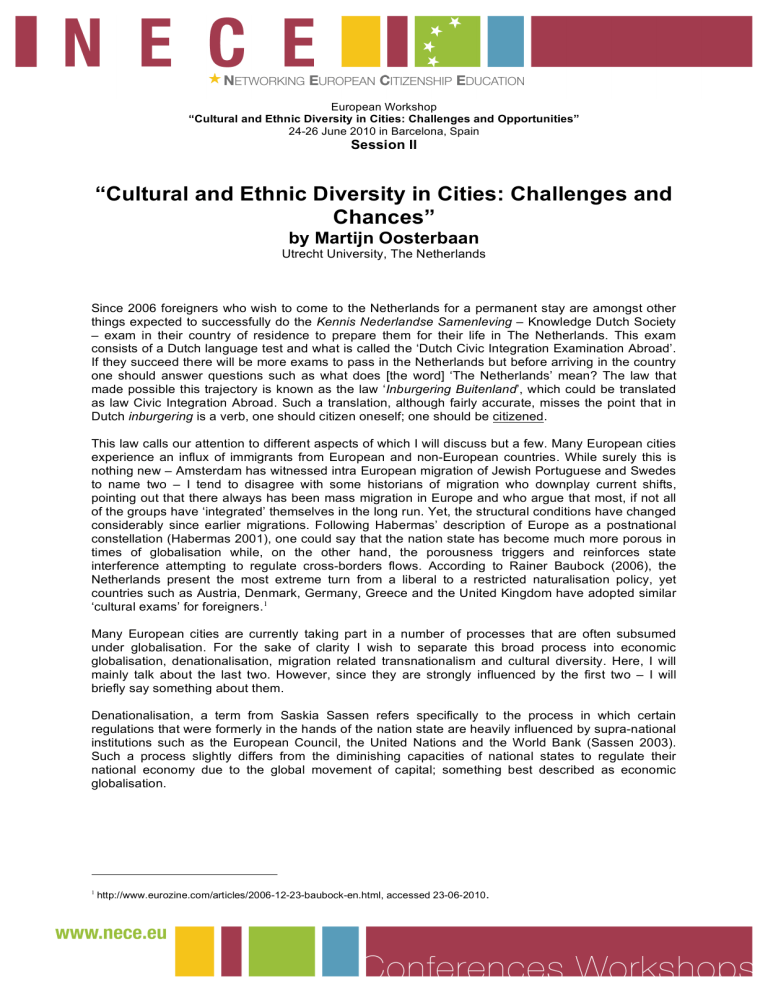
European Workshop
“Cultural and Ethnic Diversity in Cities: Challenges and Opportunities”
24-26 June 2010 in Barcelona, Spain
Session II
“Cultural and Ethnic Diversity in Cities: Challenges and
Chances” by Martijn Oosterbaan
Utrecht University, The Netherlands
Since 2006 foreigners who wish to come to the Netherlands for a permanent stay are amongst other things expected to successfully do the Kennis Nederlandse Samenleving – Knowledge Dutch Society
– exam in their country of residence to prepare them for their life in The Netherlands. This exam consists of a Dutch language test and what is called the ‘Dutch Civic Integration Examination Abroad’.
If they succeed there will be more exams to pass in the Netherlands but before arriving in the country one should answer questions such as what does [the word] ‘The Netherlands’ mean? The law that made possible this trajectory is known as the law ‘ Inburgering Buitenland ’, which could be translated as law Civic Integration Abroad. Such a translation, although fairly accurate, misses the point that in
Dutch inburgering is a verb, one should citizen oneself; one should be citizened.
This law calls our attention to different aspects of which I will discuss but a few. Many European cities experience an influx of immigrants from European and non-European countries. While surely this is nothing new – Amsterdam has witnessed intra European migration of Jewish Portuguese and Swedes to name two – I tend to disagree with some historians of migration who downplay current shifts, pointing out that there always has been mass migration in Europe and who argue that most, if not all of the groups have ‘integrated’ themselves in the long run. Yet, the structural conditions have changed considerably since earlier migrations. Following Habermas’ description of Europe as a postnational constellation (Habermas 2001), one could say that the nation state has become much more porous in times of globalisation while, on the other hand, the porousness triggers and reinforces state interference attempting to regulate cross-borders flows. According to Rainer Baubock (2006), the
Netherlands present the most extreme turn from a liberal to a restricted naturalisation policy, yet countries such as Austria, Denmark, Germany, Greece and the United Kingdom have adopted similar
‘cultural exams’ for foreigners.
1
Many European cities are currently taking part in a number of processes that are often subsumed under globalisation. For the sake of clarity I wish to separate this broad process into economic globalisation, denationalisation, migration related transnationalism and cultural diversity. Here, I will mainly talk about the last two. However, since they are strongly influenced by the first two – I will briefly say something about them.
Denationalisation, a term from Saskia Sassen refers specifically to the process in which certain regulations that were formerly in the hands of the nation state are heavily influenced by supra-national institutions such as the European Council, the United Nations and the World Bank (Sassen 2003).
Such a process slightly differs from the diminishing capacities of national states to regulate their national economy due to the global movement of capital; something best described as economic globalisation.
1 http://www.eurozine.com/articles/2006-12-23-baubock-en.html, accessed 23-06-2010
.
As Sassen and others have pointed out, these two processes influence the cityscapes of many of our
European cities – both in terms of the built environment as in terms of its demographics (and classdifferences). One of the effects of economic globalisation is the need for cheap low skilled and expensive, highly skilled labour in certain cities. Another effect is the perseverance of an inequality of life expectancies in different parts of the world, which trigger cross-border migration. Both effects influence the socio-cultural form of cities to a great extent.
This brings us to the last two processes: migration related transnationalism and cultural diversity. As many authors acknowledge, the current flow of people, capital and information leads to patterns of deterritorialization and reterritorialization of cultural practices. For migrants it is nowadays not problematic to consider themselves part of their nation of residence and of their youth or that of their parents. In many cases such sentiments are enforced by their bi-nationality, but even when it is not, it is useful to speak of migrant transnationalism in order to understand that migrants retain social, cultural and/or political ties with the countries outside the country of residence.
While such ties are closely related to the reproduction of cultural diversity, they are not the same – and it is useful to separate these two concepts. Cultural diversity is not something that is necessary related to migration; more and more people who have stayed adopt life-styles that have their strongest origins in other cultural traditions – think of religious conversion or of zumba and salsa adepts. Furthermore, several authors have challenged the notion of cultural diversity in its use as a substitute for multicultural democracy, arguing that the concept “cultural diversity” more easily slips into a uncontroversial celebration of cultural difference (often at the level of individuals), while multiculturalism – despite its many essentialist flaws – does harbour the notion of political (group) struggle.
I depart from the position that most of the people who live in cities experience cultural diversity first and foremost in and through the flux of the cityscape. Inhabitants are confronted with new sounds, new smells, new designs, new clothes, new languages and so forth. It is important to point to these sense perceptions of difference because it keeps us close the embodied experiences of difference and belonging and leads us directly to the complex notion of cultural diversity in the city.
However, it is important to note that in layman’s terms, political and scientific discussions “cultural diversity” is often framed in terms of neatly separated national, ethnic, and/or religious groups who can be identified according to certain cultural and religious dogmas. While indeed cultural diversity can be understood in terms of different values and norms please let us not forget that these values and norms are not static even if they are presented as such by people themselves. We encounter an essentialization of cultures in all domains of social life but there is a difference between the social scientific application of the concepts “culture” and “cultural diversity” and the notions of culture that people use on a daily basis to produce and deconstruct group boundaries for all kinds of reasons (see also Baumann 1996: 196).
For social scientific approaches to cultural diversity in the city it is useful to take the anthropological, holistic concept of culture as a starting point and analytically separate shared mentalities and practices from self-identified groups (communities), much along the line that Seyla Benhabib argues (2002).
Arnold Reijndorp, a Dutch urban scientist, has proposed to focus more on every-day urban practice instead of describing culture in terms of discursive representations of identity (Reijndorp 2004).
Following the work of De Certeau and Bourdieu Reijndorp who argue that every day practice leads us to see how people use city-space and how this is related to their habitus, their way of living. Such a proposal is useful because we can look beyond the supposed fixedness of cultural differences and see which practices and desires overlap. Such a remark clearly has a critical side to it. Beneath socalled rigid differences there are many practices related to globally operating firms and business opportunities. Such practices remind us that ‘a society of consumers is one of universal comparison’, as Zygmunt Bauman has put it (2000: 76).
2
The recently inaugurated Law Civic Integration Abroad points to the nation state’s perceived role in the defence of national civic culture in the face of cultural and linguistic diversity. One aspect that immediately calls our attention is the fact that according to common understanding regulated immigrants have a personal obligation to become “citizined” culturally, it is no longer considered enough to receive political citizenship after which ‘society’ will do what it used to do before – mold regulated residents into citizens. Immigrants are expected to know what makes the Netherlands, “the
Netherlands” even before they arrive. This is what Willem Duyvendak and Peter Geschiere and
Evelien Tonkens call the culturalization of citizenship .
2
A second aspect that comes to mind when we think about this law is that we are currently witnessing a new phase of reflexive essentialization of national culture. With essentialization I refer to a process of objectification of culture. Reflexivity refers to the self-conscious aspect of the process, yet it also refers to theories of reflexive modernisation as put forward by Ulrich Beck, Anthony Giddens and Scott
Lash (1994), which, simplistically put, means that knowledge of ‘society’ is instantly reintegrated in its social and political institutions and thus plays an important role in the constitution of society. To give an example, the Dutch government is supporting the construction of a national historic museum, a plan that was developed simultaneously with the plan to form a national canon (a Bildungskanon – in
German). This national canon contains important facts and events of Dutch history and presents its famous writers, politicians, artists and scientists.
Interestingly, we see in both projects a seemingly paradoxical movement, the wish to objectify what the Netherlands is – and who ‘we are’ – while acknowledging that ‘our society’ is currently undergoing a profound shift, most noticeable in the larger cities of the country. Such a shift, perhaps best described by Zygmunt Bauman’s description of the transition to a liquid modernity, challenges efforts to solidify and essentialize cultural knowledge and practice (Bauman 2000). With regard to cultural identity, Peter Geschiere and Birgit Meyer have called this “the paradox of flow and closure of identity”
(Geschiere and Meyer 1998). Such a paradox is closely related to the strange fact that foreigners are supposed to learn about Dutch culture, while not being there, a practice that runs counter to more holistic notions of culture common in the field of cultural anthropology.
A third aspect of the Civic Integration Law – related to the first two – is the apparent concern that migrants do not know enough about the Netherlands and Dutch culture to become integrated.
Recently Willem Schinkel has written a beautiful work on the sociological and philosophical fallacies regarding the notion of integration, criticizing the concept by arguing that it is in fact an empty signifier which derives its force from its link to the powerful image of society as an organic whole (Schinkel
2007). In certain works on the city we find a related strand of thinking about integration and wholeness, although perhaps in slightly different words, with different connotations and traditions of thought.
Cities have traditionally been the locus and the context to think about large-scale transformations.
Sociological discussions about the transition from tradition to modernity are firmly rooted in urban transformations and experiences. Whether one looks at the works of Georg Simmel, Walter Benjamin or Richard Sennet, they all point to urban experiences in order to discuss the particularities of socalled modern life. One of the important aspects in the work of all these authors is their focus on public life of cities. Surely ignoring the variations in their thinking, one could say that cities offer people the possibility to – or perhaps better said, force people to – develop their ‘modern’ individuality by taking part (or not) in larger loosely bounded collectives on a semi-voluntary basis. Key characteristics of city life are the possibility to be anonymous and the challenge to cope with strangers.
2
2 http://www.fmg.uva.nl/actueel/fmgnieuwsarchief.cfm/45FA8444-1321-B0BE-A46AFA0DE28AE677
3
While these authors have described this transition in historical terms, the normative flip-side of this twin development of individuality and collective life in the city is the fear that people remain isolated in strongly bounded communities that do not allow for a shared collective social and political life nor allow people to develop the kind of individuality that is considered good. Such discussions are often articulated with discussions on immigration and cultural and ethnic difference. As a consequence fears of isolated communities become connected to a critique of the multi-cultural government policies of the past, which were said to enforce rather than diminish cultural ‘tribalization’ in the city.
In several works on the multi-cultural city in the Netherlands we encounter the thought that city life can only remain ‘healthy’ when people develop cross-cultural, or cross-ethnic ties and take part in the collective life in the city. In the Netherlands government agencies have become quite concerned with what they call the ‘social cohesion’ of the city. The language of cohesion comes quite close to the language of integration. For example, one of the often-heard claims is that the availability of transnational (digital) media allows so-called city newcomers to ‘remain’ part of the socio-cultural sphere of their country of origin. According to some of the proponents of this claim, participation in transnational public spheres hampers participation in public city life, enforcing city segregation, threatening civil cohesion. As Justus Uitermark and Frank van Steenbergen have shown, as a result of this new paradigm the Municipal government of Amsterdam chooses more and more to support
‘intercultural’ organizations rather than organizations based upon ethnic descent (Uitermark and
Steenbergen 2006).
A fourth and last aspect I wish to discuss here is the fact that the Civic Integration Law also exists as token in the public debates simplified and reproduced in the national broadcast media. The encounters between city dwellers and so-called strangers are also defined by the public debates in press and in the other media. The result of this dynamic is that the stranger can be a familiar stranger in two ways, the person that is known by virtue of its propinquity and regular appearance in the neighborhood and the person that is already known as ‘the stranger’ the one that is mostly defined in terms of his difference.
My work on Brazilian migrants in Amsterdam does not depart from – nor strengthens this fear of tribalization but describes ethnographically how social-groups are constituted performatively and in close relation to structural conditions. Going beyond presupposed distinctions between ethnic-religious groups, ethnographic accounts of Brazilian migrants in Amsterdam demonstrate that a variety of parties and forces are involved in the constitution of public encounters in the city: the built environment of the city; the transformations of digital media; the Dutch state, business ventures; the labour market; the city council, etcetera .
For many Brazilians state regulation and control of the entry and mobility of vreemdelingen
(strangers/foreigners) remains the principal obstacle to participation in public city life. Brazilians without valid documents have no possibilities to take part in the formal institutions of the city and they run the risk of being apprehended, imprisoned and deported. Yet, that does not mean these Brazilians live isolated lifes, personally or collectively. Many undocumented Brazilians work as house-cleaners and maintain good relations with their native Amsterdam employers and many Brazilians – with and without documents – take part in collective gatherings in the city. Some regularly go the Catholic
Parish or a Protestant church and others make music or play sports together.
Such encounters question some of the presuppositions concerning civic integration and cultural isolation. Even Brazilians who have no documents and have certainly not passed the Dutch Civic
Integration Examination, feel connected to the city and its inhabitants in various ways. Besides such encounters in the city, Brazilian migrants in Amsterdam use popular Social Network Sites as online meeting points. Participation in some of the popular Social Network Sites enforce face-to-face meetings in the city, while simultaneously allowing for transnational communication among fellow migrants and people ‘back-home’. One could be tempted to view the creation of transnational virtual communities of Brazilians as an example of cyberbalkanization, reproducing separate discursive arenas, enforcing the tribalization of the public sphere. Without theoretically discarding such a possibility, day-to-day online and offline practices of Brazilians demonstrate that Brazilian migrants cannot be considered a homogeneous group nor should they be viewed as isolated or inward looking.
4
Though Brazilians regularly form groups with other Brazilian migrants, these groups are formed according to religious, class and cultural differences. Some Brazilians partake in Capoeira groups that often consist of a mélange of international people while others primarily gather in one of the several
Brazilian-Pentecostal congregations in the city (Oosterbaan 2010a, 2010b).
What is thus sometimes portrayed as a single community of Brazilian migrants is in fact a multilayered collection of groups with conjunctures and disjunctures. Each of these groups has online mirrors, which contain different transnational ties. Some virtual communities primarily support relations with Brazilian organizations in Brazil, while others also consist of Pan-European networks. The amalgam of offline and online communities maintaining different transnational relations, supporting different encounters with other groups in the city point to the fact that we need a complex model of public city life that allows for questions about solidarity and cultural exchange yet understands collectives as performatively constituted. One of the questions thus is if Civic Integration laws and institutions serve the purpose of facilitating and/or strengthening the publicity of European cities or if it is primarily a reaction to the fear of losing a dreamed homogeneity.
References
Beck, Ulrich, Anthony Giddens and Scott Lash. 1994. Reflexive Modernization:
Politics, Tradition and Aesthetics in the Modern Social Order . Cambridge: Polity Press
Benhabib, Seyla. 2002. The Claims of Culture: Equality and Diversity in the Global
Era. Princeton: Princeton University Press. Introduction, pp 1-16.
Bauman, Zygmunt. 2000. Liquid Modernity . Cambridge: Polity Press
Baumann, Gerd. 1996. Contesting Culture. Discourses of identity in multi-ethnic
London . Cambridge: Cambridge University Press
Geschiere, Peter and Birgit Meyer. 1998. Globalization and Identity: Dialectics of
Flow and Closure. Introduction. Development and Change 29(4), pp 601-615.
Habermas, Jürgen. 2001. The Postnational Constellation: Political Essays .
Cambridge: Polity Press. ISBN: 0-7456-2352-2. Chapter 4, pp 68-89.
Oosterbaan, Martijn. 2010a. Virtual Migration. Brazilian Diasporic Media and the
Reconfigurations of Place and Space, Revue Européenne des Migrations Internationales
26(1) 2010. Poitiers. Pp. 81-102.
2010b. Virtual Re-evangelization: Brazilian Churches, Media and the Postsecular City. In: Beaumont, J, A. Molendijk and C. Jedan. Exploring the
Postsecular: the religious, the political, the urban . Brill’s International Series in Religion and
Society.
Reijndorp, Arnold. 2004. Stadswijk. Stedenbouw en dagelijks leven . Rotterdam: NAi
Uitgevers,
Sassen, Saskia. 2003. Globalization or denationalization? Review of International
Political Economy 10(1), pp. 1–22. Pp 1-18.
Schinkel, Willem. 2007. Denken in een tijd van sociale hypochondrie
Aanzet tot een theorie voorbij de maatschappij . Klement/Pelckmans
Uitermark, Justus and Frank van Steenbergen. 2006. Postmulticulturalisme en stedelijk burgerschap: Over de neoliberale transformatie van het Amsterdamse integratiebeleid, Sociologie 2(3), pp. 265-287
5


